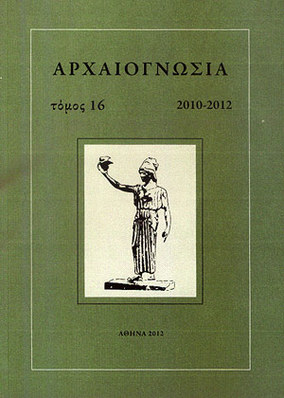Ο μύθος του Καιάδα
Part of : Αρχαιογνωσία ; Vol.9, No.1-2, 1995, pages 207-234
Issue:
Pages:
207-234
Parallel Title:
The legend of Kaeadas
Section Title:
Μελέτες-Articles
Author:
Abstract:
Most approaches concerning the interpretation of the rejection of infants in Sparta lead to the criticism of the Spartan way of thinking and of the Spartan society and not to the understanding of this particular practice and its position within the frame of certain historical conditions.Since the middle of the 17th century until now, with a few exceptions, the rejection of difformed infants in Sparta is caracterized as a barbaric and cruel action dictated by the principle of eugenisme, exremely useful for a state governed by a military government which considers that every Spartan belongs exclusively to the city.Incredible as it may seem, such an opinion, concerning this particular kind of Spartan “cruelty” is not shared by any ancient writer. The only piece of literary evidence we possess (Plut. Lyc. 16, 1-3), shows a spiritual relation with certain views expressed by Plato, which do not concern Spartan practices.The relevant passages in Plutarch’ text raise five important issues: health examination, eugenism, allotment of inheritance, throwing defformed children to Kaeadas and the role of the philetes in relation to paternal authority over children.In the closed society of the homoioi, where endogamous relations were prevailing, the phenomenon of defformed infants must have been very common. This might have been the reason for medical examination of children by the elders. This procedure concerning the examination of the child by the philetes, has also to do with the allotment of inheritance to the child. The character, as well as the significance of this allotment of inheritance was different before and after the law of Epitadeas.There is no evidence (Plutarch included) correlating Apothetes with Kaeadas. If there is a conceptual identification between Kaeadas and Apothetes -two onomatolog- ical definitions implying a precipice- this pays tribute to the logical reasoning which stems out of the already formed conception concerning Spartan cruelty.The legendary precipitation to Kaeadas concerns individuals condemned to death or corpses and not children defformed or handicapped by birth.The fact that Spartan fathers present their children to the philetes, presupposes a previous stage during which those children had already been recognized by their fathers (something relevant to the rite of Amphidromia in Athens). In other words, the father was presenting to the clan only the children that he desired to raise.The fact that in Sparta the rejection of healthy children was not done through the usual way of abandoning them (as in Athens) was due to a different structure of the city’s social stratification.The presence of the philetes concerns the procedure of introducing and registering the child in the tribe, a process which is not under the family’s jurisdiction. The important role of the philetes can then be inerpreted, independently of any kind of paternal authority (something relevant to the Athenian Apatourea).In the ancient world, the Spartan custom of rejection has its place within the broader ways of rejecting undesirable children. The sole particularity observed in Sparta’s case is that this rejection is limited and applied only in abnormal children and not in the healthy ones, as it often happens in other cities.Plutarch’s testimony also functions as an inducement to limit the rejection of healthy infants, a frequent phenomenon of those days. The theories concerning Spartan eugenism in a military governed society, as well as the excessive role of the philetes upon family and private life within the frame of Spartan society, which is seen mostly as coenobitic, both stem out and constitute inseparable parts of the Spartan myth which owes its origin mainly to Plutarch.
Subject:
Subject (LC):
Keywords:
Σπάρτη
Notes:
Ο Ν. Μπιργάλιας ευχαριστεί ιδιαιτέρως τον κ. Μ. Χατζόπουλο τόσο για τη συμβολή που είχε με τις χρήσιμες παρατηρήσεις του στην παρούσα μελέτη, όσο και για τον τρόπο με τον οποίο την υποδέχθηκε




